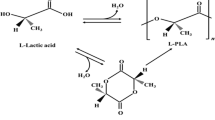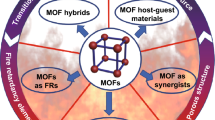Abstract
In the present work, we have studied the flame-retardant properties of phosphorus-functionalized multi-walled carbon nanotubes (MWCNTs) created by treating oxidized MWCNTs (O-MWCNTs) with phosphoric acid. These phosphorus MWCNTs (P-MWCNTs), along with pristine MWCNTs and O-MWCNTs, were incorporated into polystyrene (PS) and poly (methyl methacrylate) (PMMA) by solution blending at lower concentrations (0.5–10 mass%) than conventional organophosphorus flame retardants (5–30 mass%). Thermal properties of the PS and PMMA polymer nanocomposites were subsequently investigated through thermogravimetric (TG) analysis and microcombustion calorimetry. Scanning electron microscopy was used to evaluate P-MWCNT dispersion in each polymer matrix. P-MWCNTs were well-dispersed in PS, improved PS thermal stability during nitrogen pyrolysis in proportion to the phosphorus loading, and led to an improvement in PS flammability properties. In contrast, the P-MWCNTs were more aggregated in PMMA and only moderately improved PMMA thermal stability during pyrolysis. In both PS and PMMA, P-MWCNTs were more effective than either MWCNTs or O-MWCNTs at improving each polymer’s thermal oxidative stability during combustion in air. Characterization of the P-MWCNT nanoparticles, the PS and PMMA nanocomposites, and TG residues indicated that P-MWCNT flame retardants primarily act in the condensed phase, encouraging char formation of the dispersed MWCNT network as a route to protecting the polymer. By comparing results of polymer composites containing MWCNTs, O-MWCNTs or P-MWCNTs at comparable loadings, data from the current study indicate that phosphorus incorporation can improve the fire-retardant properties of MWCNTs, although optimizing P-MWCNT dispersion in different polymers remains critical to optimizing the flame-retardant effect.









Similar content being viewed by others
References
Horrocks AR, Kandola BK, Davies PJ, Zhang S, Padbury SA. Developments in flame retardant textiles: a review. Polym Degrad Stab. 2005;88(1):3–12.
Chattopadhyay DK, Webster DC. Thermal stability and flame retardancy of polyurethanes. Prog Polym Sci. 2009;34:1068–133.
Weil ED, Levchik SV. Flame retardants for plastics and textiles: practical applications. Munich: Hanser Publications; 2009.
Laoutid F, Bonnaud L, Alexandre M, Lopez-Cuesta JM, Dubois P. New prospects in flame retardant polymer materials: from fundamentals to nanocomposites. Mater Sci Eng, R. 2009;2009(63):100–25.
Zhang S, Horrocks AR. A review of flame retardant polypropylene fibres. Prog Polym Sci. 2003;28:1517–38.
Levchik SV, Weil ED. Thermal decomposition, combustion, and flame-retardancy of epoxy resins: a review of the recent literature. Polym Int. 2004;53(12):1901–29.
Levchik SV, Weil ED. A review of recent progress in phosphorus-based flame retardants. J Fire Sci. 2006;24:345–64.
Rakotomalala M, Wagner S, Doring M. Recent developments in halogen free flame retardants for epoxy resins for electrical and electronic applications. Materials. 2010;3:4300–27.
USEPA. An alternatives assessment for the flame retardant decabromodiphenyl ether (DecaBDE). United States Environmental Protection Agency 2014.
Kashiwagi T, Grulke EA, Hilding J, Harris R, Awad W, Douglas J. Thermal degradation and flammability properties of poly(propylene)/carbon nanotube composites. Macromol Rapid Commun. 2002;23:761–5.
Cipiriano BH, Kashiwagi T, Raghavan SR, Yang Y, Grulke EA, Yamamoto K, et al. Effects of aspect ratio of MWNT on the flammability properties of polymer nanocomposites. Polymer. 2007;48(20):6086–96.
Goncalves AG, Jarrais B, Pereira C, Morgado J, Freire C, Pereira MFR. Functionalization of textiles with multi-walled carbon nanotubes by a novel dyeing-like process. J Mater Sci. 2012;47:5263–75.
Kim Y, Davis R. Multi-walled carbon nanotube layer-by-layer coatings with a trilayer structure to reduce foam flammability. Thin Solid Films. 2014;550:184–9.
He Z, Yuan T, Yan X, Ding D, Wang Q, Luo Z, et al. Flame-retardant polypropylene/multiwall carbon nanotube nanocomposites: effects of surface functionalization and surfactant molecular weight. Macromol Chem Phys. 2014;215:327–40.
Ebadi M, Mirdamadian Z, Ghanbari D, Moradi L. The effect of aminated carbon nanotube and phosphorus pentoxide on the thermal stability and flame retardant properties of the acrylonitrile–butadiene–styrene. J Cluster Sci. 2014;25(2):541–8. doi:10.1007/s10876-013-0633-9.
Kim JH, Dao TD, Jeong HM. Aluminum hydroxide–CNT hybrid material for synergizing the thermal conductivity of alumina sphere/thermoplastic polyurethane composite with minimal increase of electrical conductivity. J Ind Eng Chem. 2016;33:150–5.
Kashiwagi T, Du F, Douglas JF, Winey KI, Harris RH, Shields JR. Nanoparticle networks reduce the flammability of polymer nanocomposites. Nat Mater\. 2005;4:928–33.
Kashiwagi T, Fagan J, Douglas JF, Yamamoto K, Heckert AN, Leigh SD, et al. Relationship between dispersion metric and properties of PMMA/SWNT nanocomposites. Polymer. 2007;48:4855–66.
Iijima S. Helical microtubules of graphitic carbon. Nature. 1991;354:56–8.
Zhang W, Johnson L, Silva SRP, Lei MK. The effect of plasma modification on the sheet resistance of nylon fabrics coated with carbon nanotubes. Appl Surf Sci. 2012;258:8209–13.
Zhang W, Tan Y, Wu C, Silva S. Self-assembly of single walled carbon nanotubes onto cotton to make conductive yarn. Particuology. 2012;10:517–21.
Liu Y, Wang X, Qi K, Xin J. Functionalization of cotton with carbon nanotubes. J Mater Chem. 2008;18:3454–60.
Liu Y, Tang J, Wang R, Lu H, Li L, Kong Y, et al. Artificial lotus leaf structures from assembling carbon nanotubes and their applications in hydrophobic textiles. J Mater Chem. 2007;17:1071–8.
Rajeshwari P. Kinetic analysis of the non-isothermal degradation of high-density polyethylene filled with multi-wall carbon nanotubes. J Therm Anal Calorim. 2016;123:1523–44.
Cheng HKF, Chong MF, Liu E, Zhou K, Li L. Thermal decomposition kinetics of multiwalled carbon nanotube/polypropylene nanocomposites. J Therm Anal Calorim. 2014;117:63–71.
Huang YY, Terentjev EM. Dispersion of carbon nanotubes: mixing, sonication, stabilization, and composite properties. Polymers. 2012;4:275–95.
Jogi B, Sawant M, Kulkarni M, Brahmankar P. Dispersion and performance properties of carbon nanotubes (CNTs) based polymer composites: a review. J Encapsul Adsorpt Sci. 2012;2:69–78.
Bellayer S, Gilman J, Eidelman N, Bourbigot S, Flambard X, Fox DM, et al. Preparation of homogeneously dispersed multiwalled carbon nanotube/polystyrene nanocomposites via melt extrusion using trialkyl imidazolium compatibilizer. Adv Funct Mater. 2005;15:910–6.
Sun G, Chen G, Liu J, Yang J, Xie J, Liu Z, et al. A facile gemini surfactant-improved dispersion of carbon nanotubes in polystyrene. Polymer. 2009;50(24):5787–93.
Slobodian P, Svoboda P, Riha P, Boruta R, Saha P. Synthesis of PMMA-co-PMAA copolymer brush on multi-wall carbon nanotubes. J Surf Eng Mater Adv Technol. 2012;2:221–6.
Tangtubtim S, Saikrasun S. Effect of functionalized CNTs and liquid crystalline polymer on thermo-oxidative stability of polyethylene-based hybrid composites. J Therm Anal Calorim. 2017;128:235–47.
Shanmugharaj AM, Bae JH, Lee KY, Noh WH, Lee SH, Ryu SH. Physical and chemical characteristics of multiwalled carbon nanotubes functionalized with aminosilane and its influence on the properties of natural rubber composites. Compos Sci Technol. 2007;67:1813–22.
Noparvar-Qarebagh A, Roghani-Mamaqani H, Salami-Kalajahi M, Kariminejad B. Nanohybrids of novolac phenolic resin and carbon nanotube-containing silica network. J Therm Anal Calorim. 2017;128(2):1027–37.
Wesolek D, Gieparda W. Single- and multiwalled carbon nanotubes with phosphorus based flame retardants for textiles. J Nanomater. 2014;2014:1–6.
Zhang T, Hongqiang Y, Peng M, Wang L, Ding H, Fang Z. Construction of flame retardant nanocoating on ramie fabric via layer-by-layer assembly of carbon nanotube and ammonium polyphosphate. Nanoscale. 2013;2013(5):3013–21.
Ma H, Tong L, Xu Z, Fang Z. Functionalizing carbon nanotubes by grafting on intumescent flame retardant: nanocomposite synthesis, morphology, rheology, and flammability. Adv Funct Mater. 2008;18:414–21.
Xing W, Yang W, Yang W, Hu Q, Si J, Lu H, et al. Functionalized carbon nanotubes with phosphorus- and nitrogen- containing agents: effective reinforcer for thermal, mechanical, and flame-retardant properties of polystyrene nanocomposites. ACS Appl Mater Interfaces. 2016;. doi:10.1021/acsami.6b06864.
Ortega KDF. Insight into the acid-base properties of functionalized multiwall carbon nanotubes [Ph. D. Dissertation]. Berlin: Fritz Haber Institute of the Max Planck Society; 2014.
Spitalsky Z, Tasis D, Papegelis K, Galiotis C. Carbon nanotube-polymer composites: chemistry, processing, mechanical and electrical properties. Prog Polym Sci. 2010;35(3):357–401.
Wepasnick KA, Smith BA, Schrote KE, Wilson HK, Diegelmann SR, Fairbrother DH. Surface and structural characterization of multi-walled carbon nanotubes following different oxidative treatments. Carbon. 2011;49(1):24–36.
Mahajan A, Kingon A, Kukovecz A, Konya Z, Vilarinho PM. Studies on the thermal decomposition of multiwall carbon nanotubes under different atmospheres. Mater Lett. 2013;90:165–8.
Pang LSK, Saxby JD, Chatfield SP. Thermogravimetric analysis of carbon nanotubes and nanoparticles. J Phys Chem. 1993;97(27):6941–2.
Koh B, Cheng W. The impact of sonication on the surface quality of single-walled carbon nanotubes. J Pharm Sci. 2015. doi:10.1002/jps.24483.
Cameron GG, Kerr GP. Thermal degradation of polystyrene-I. Chain scission at low temperatures. Eur Polym J. 1968;4:709–17.
Cameron GG, Kerr GP. Thermal degradation of polystyrene-II. The role of abnormalities. Eur Polym J. 1970;6:423–33.
Cameron GG, Meyer JM, McWalter IT. Thermal degradation of polystyrene. 3. A reappraisal. Macromolecules. 1978;11(4):696–700.
Cameron GG, McWalter IT. Thermal degradation of polystyrene-4. Decomposition of oxygen-containing polymers. Eur Polym J. 1982;18:1029–32.
Cameron GG, Bryce WAJ, McWalter IT. Thermal degradation of polystyrene-5. Effects of initiator residues. Eur Polym J. 1984;20(6):563–9.
Guyot A. Recent developments in the thermal degradation of polystyrene-a review. Polym Degrad Stab. 1986;15:219–35.
Moldoveanu SC. Analytical pyrolysis of synthetic organic polymers. Netherlands: Elsevier; 2005.
Kashiwagi T, Atsushi I, Brown JE, Hatada K, Kitayama T, Masuda E. Effects of weak linkages on the thermal and oxidative degradation of poly(methyl methacrylates). Macromolecules. 1986;19:2168–73.
Manring LE. Thermal degradation of saturated poly(methyl methacrylate). Macromolecules. 1988;21:528–30.
Manring LE. Thermal degradation of poly(methyl methacrylate). 2. Vinyl terminated polymer. Macromolecules. 1989;22:2673–7.
Manring LE, Sogah DY, Cohen GM. Thermal degradation of poly(methyl methacrylate). 3. Polymer with head-to-head linkages. Macromolecules. 1989;22(12):4652–4.
Manring LE. Thermal degradation of poly(methyl methacrylate). 4. Random side-group scission. Macromolecules. 1991;24:3304–9.
Holland BJ, Hay JN. The kinetics and mechanisms of the thermal degradation of poly(methyl methacrylate) studied by thermal analysis-fourier transform infrared spectroscopy. Polymer. 2001;42:4825–35.
Chiantore O, Camino G, Costa L, Grassie N. Weak links in polystyrene. Polym Degrad Stab. 1981;3:209–19.
Holland BJ, Hay JN. The effect of polymerisation conditions on the kinetics and mechanisms of thermal degradation of PMMA. Polym Degrad Stab. 2002;77:435–9.
Levchik S, Levchik G. Mechanism of action of phosphorus-based flame retardants in nylon 6. III. Ammonium polyphosphate/manganese dioxide. Fire Mater. 1996;20:183–90.
Wang X, Wu L, Li J. Synergistic flame retarded poly(methyl methacrylate) by nano-ZrO2 and triphenylphosphate. J Therm Anal Calorim. 2011;103:741–6.
Schartel B. Phosphorus-based flame retardancy mechanisms-old hat or a starting point for future development? Materials. 2010;3:4710–45.
Wepasnick KA, Smith BA, Bitter JL, Fairbrother DH. Chemical and structural characterization of carbon nanotube surfaces. Anal Bianal Chem. 2010;396(3):1003–14. doi:10.1007/s00216-009-3332-5.
Carpenter C, Shipway P, Zhu Y, Weston D. Effective dispersal of CNTs in the fabrication of electrodeposited nanocomposites. Surf Coat Technol. 2011;205:4832–7.
Walters RN, Safronava N, Lyon RE. A microscale combustion calorimeter study of gas phase combustion of polymers. Combust Flame. 2015;162:855–63.
Ma PC, Kim JK, Tang BZ. Effects of silane functionalization on the properties of carbon nanotube/epoxy nanocomposites. Compos Sci Technol. 2007;67:2965–72.
Amirian M, Chakoli A, Cai W, Sui J. Effect of functionalized multiwalled carbon nanotubes on thermal stability of poly (L-LACTIDE) biodegradable polymer. Sci Iran. 2013;20(3):1023–7.
Acknowledgements
We acknowledge funds from the Johns Hopkins University (JHU) Water SEED Grant, the Air Force Office of Scientific Research (AFOSR), and the National Institute of Standards and Technology (NIST). We are grateful to the National Institute of Standards and Technology (NIST), the U.S. Naval Academy (USNA), and the JHU McQueen Lab (Kathyrn Arpino and Benjamin Trump) for facilities support. Particular thanks go to Dr. Joe Lomax, Dr. Maria Schroeder, Dr. Jeff Fitzgerald, and Dr. Patrick Fahey at USNA for many helpful discussions throughout the study.
Author information
Authors and Affiliations
Corresponding author
Ethics declarations
Conflict of interest
The authors declare no competing financial interest. Any opinions, findings and conclusions, or recommendations expressed in this manuscript are those of the authors and do not reflect the views of the US Air Force or the US Navy.
Electronic supplementary material
Below is the link to the electronic supplementary material.
Rights and permissions
About this article
Cite this article
Durkin, D.P., Gallagher, M.J., Frank, B.P. et al. Phosphorus-functionalized multi-wall carbon nanotubes as flame-retardant additives for polystyrene and poly (methyl methacrylate). J Therm Anal Calorim 130, 735–753 (2017). https://doi.org/10.1007/s10973-017-6432-z
Received:
Accepted:
Published:
Issue Date:
DOI: https://doi.org/10.1007/s10973-017-6432-z




